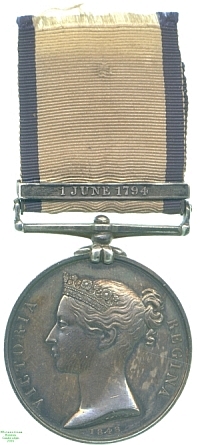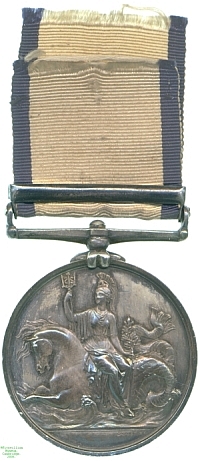
Obverse, a bust of Queen Victoria

Reverse, Britannia with a trident seated sideways on a seahorse

Obverse, a bust of Queen Victoria |

Reverse, Britannia with a trident seated sideways on a seahorse |
Just as in 1848 the extensive land campaigns of the Napoleonic Wars and the other conflicts of the pre-Victorian era were recognised by the issue of the Military General Service Medal, those serving in the Navy at the time were recognised with the Naval General Service Medal. As with the Army equivalent and the East India Company's related award, many of the battles for which the medal was awarded had been fought so long ago that few if any claimants survived.
In addition, bars were awarded for many actions whose significance and size were, despite the heroism displayed by those involved, relatively minor. The result was that many of the bars were issued in tiny numbers, with some combinations all but unique, and the medals command a very high price among collectors because of this rarity and individuality. This in turn, along with the manufacture in most cases of more bars than were eventually issued, has led to the `improvement' of many common awards where recipients' names are shared with those present at `rarer' battles. The medal also shares with the Military General Service and Army of India Medals the oddity that Queen Victoria, whose portrait they bear, was not the ruler under whom the battles for which it was awarded were fought.
The Glorious First of June, otherwise known as the Third Battle of Ushant, was the first major naval battle of the Napoleonic Wars, a fleet clash following several days of inconclusive skirmishing around a large convoy that the French fleet was trying to bring through the British blockade. On 1 June the wind finally favoured the British and Admiral Lord Howe fell upon the French fleet and savaged it, for although 8 British ships were seriously damaged none were sunk, while 7 French ships went to the bottom and 13 more were badly shot about. The French could console themselves with the safe arrival of the convoy.
Although it is not the medal in the Watson Collection, it is recorded that one Daniel MacKenzie was actually born aboard HMS Tremendous during the battle (his mother, the wife of one the sailors, having come aboard with his father) and was therefore awarded the Naval General Service Medal in 1848 with this bar, and a rating of `baby'.
This medal is however inscribed to Able Bodied Seaman George Eyres of the 74-gun first-rate HMS Leviathan. Leviathan's captain, Lord Hugh Seymour, received a gold medal for the ship's part in the same engagement. The Medal Roll records the award of this medal to a man named "Ayres", and the mistake is not impossible, but an AB George Eyres was awarded the far commoner bar for Syria, which raises the possibility that this is actually the Syria recipient's medal unscrupulously equipped with a leftover clasp for 1st June 1794 to increase its value.
Be that as it may, Lester Watson purchased this medal at some point before 1928.